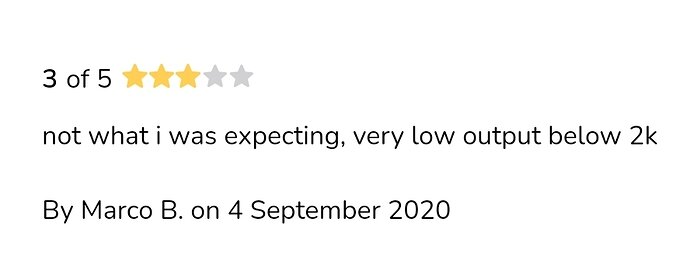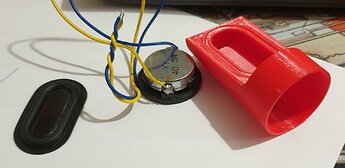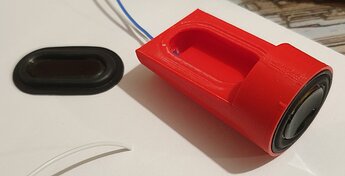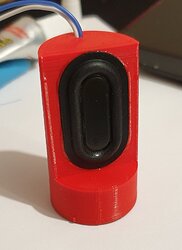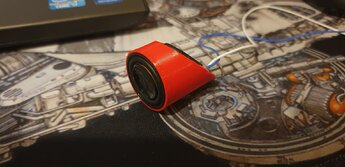in short yes, the variables would be the density of foam, type of foam, and how thick it will be.
but yes this would help slow down the air pressure waves from the back of the speaker.
have a play and see what happens.
i find sound is a very personal so it all depends mostly on what you like to hear.
This finally arrived, it’s a 40mm full range driver from Dayton Autio. I posted the link above if you would like to find out more specs.
I’m hoping that this will offer the full package in terms of sound reproduction and volume.
Update for the dayton audio speaker.
After I printed a new enclosure for it I’m very happy with it.
The sound is good, bass is tighter and the highs are defined.
Next step is to shoe horn it into a hilt and make it look like it supposed to be there🤣
I removed the corners and then turned it on my lathe to get it nice and round (I went oh so gently  )
)
Measure 41mm diameter now so it’s not too big.
41mm is bigger than any speaker I have in any of my sabers, but if you’re making a pommel from scratch you can probably make something that can house it.
Yeah it is pretty large for any saber build but the sound is superb👌
I was looking at a 33mm BMR driver for the next build just to make it easier.
The difference between a 28 and 40 is very noticeable in both volume and sound quality👍.
I’m very happy with this particular set up and glad that the low voltage crackle caused by the cheap speakers has gone now I’m using the dayton audio one.
I will only be buying good quality speakers from now on👍.
As a foot note, the 28mm speakers are still good I just wanted more. The closed and tuned cabinet seems to be working… or at least the one I have done for this build.
The next step as my son is having the 28mm speaker I no longer need, will be to test it in a classically mounted holder Vrs a tuned and sealed chamber / cabinet.
I’m guessing the gains might be minimal but will know more once I’ve had a play.
for those of you who use the 28mm bass speaker, I have done some modelling on the speaker chamber.
I used a TCS 28mm 3W Bass/WOW speaker for the tests.
speaker requires about 10ml of air in the cabinet giving us a resonance of approx. 335.2Hz.
Internal cabinet size was 26mm dia X 18.8mm deep. (volume was 9.98ml)
first test was to print a typical set up with small cut outs for the solder pads on the sides to the speaker. this gives small openings that will vent the rear of the speaker to open air.
on testing this (in theory) would reduce the bass response and cause the sound to become tinny.
second test was to totally seal off the rear of the speaker but still keep the enclosure behind the speaker the same dimensions.
it did to my ears add a little more bass definition (bass punch was a little better pronounced) but to be honest as I was only using 1 rig to do both tests and so couldn’t run them side by side, i would say that it proved to be very minimal.
I think it may be down to the size of the speaker and the diaphragm exertion distance that is the limiting factor with this type of set up.
but if you are looking to eek out every last bit of performance then designing a speaker enclosure that would seal the rear of the speaker is definantly recommended as this would allow the speaker to work at its optimal performance.
I liked the idea of an audio tools directory with cmdline helper scripts for audio processing and font element generation. I’m thinking DOS level tools and batch scripts tho, so I don’t know how that would support Apple and *nix community…
Going to be having a play with one of these…
https://www.daytonaudio.com/product/1138/ce32a-4-1-1-4-mini-speaker-4-ohm
it’s marginally larger than the regular 28mm speakers used but I’m hoping it will perform well as it’s rated frequency response is 240 - 20,000 Hz.
I was bashing with this:
saw that, looked at the code, excellent work
while testing the 32mm speaker below it had no difference in audio quality or volume so I have to say that I was rather disappointed. (although I must admit that I was not expecting great things)
https://www.daytonaudio.com/product/1138/ce32a-4-1-1-4-mini-speaker-4-ohm
So i had to take it back to the drawing board and look at what exactly makes speakers work their magic, so to speak.
the main features that affect how speakers create good sonic features are;
diaphragm / cone shape (concave, flat, etc)
diaphragm / cone size (bigger is better in most cases)
voice coil size (diameter) and power rating (watts)
diaphragm suspension size and material (rubber, foam etc)
diaphragm / cone excursion (how much is moves (Xmax))
I noted that with all the small speakers that I have tested that struggled to produce the low frequencies had small diaphragm / cone excursion (0.2mm - 0.5mm) although some better ones (like to WOW speakers) go up to 1mm.
so with this in mind I set out to find a well made small speaker that would have a good suspension, a high excursion, large diaphragm / cone size while not being to big to realistically fit into a hilt.
my search led me to this.
it has a very large suspension and a huge excursion! 4.5mm!
all fitting into a 36mm package once I modify it a little.
so I think I will have a go with this one and see what it brings. 
I applaud your systematic work with this. I would have given up a while ago.
I do hope this review on the product page is wrong though:
Thank you, but its more a case of searching for that emersion in the sounds made by the saber.
As you may have seen above I shoe horned in a DMA45-4 from daton audio.
At 40mm this driver is massive compared to what is normally fitted… but the sound, volume as well as the feel is spot on.
It is just too big to really make it work in a hilt without looking like you have a detonator attached to the pomel🤣
Its amazing that we have these professionally made sound fonts but then we use some of the smallest speakers because of the constraints of the hilt.
The energy and feel we loose because of that is huge and I didn’t know how much until I had listened to some fonts through my earphones late one night.
Since then I’ve tried to find that happy medium.
I’ve got both ends sorted though😆 with my 24mm coming in last place and my 40mm coming in top!
Just got to find something that works for myself and possibly the masses if they like to dabble.
I’ve been talking to some of the manufacturers lately to see is making a custom speaker could be achieved but the investment costs are a bit out of my league  but at least 2 have responded with a yes we can do something like that… so maybe in the future when I have a spare 5k sitting around I may just go for it.
but at least 2 have responded with a yes we can do something like that… so maybe in the future when I have a spare 5k sitting around I may just go for it.
https://crucible.hubbe.net/t/dual-speakers/1054?u=driftrotor
thought I’d link this thread as it’s interesting and kind of relevant.
I think its great that others are thinking of ways to improve the sound emitted from our sabers.
I’m hoping my parts will turn up soon and I can test the passive radiator design.
this in theory should enhance what the small speakers are lacking and give a more dynamic sound.
I mean, our speaker do a great job at producing nice clear highs but lack the depth of the bass from our sound fonts.
playing with my saber that houses a huge 40mm speaker is just awesome!
the depth of the bass really drives home that all important immersive feel and adds dynamics you could only dream of.
if only we could get the same performance from the smaller speakers!
that would be awesome!
for those interested, this is my mock up of a passive radiator design.
https://www.dropbox.com/s/mtztn9rfokaz3x0/Screenshot%20%28158%29.png?dl=0
the port is tuned to reflect and disrupt the high frequencies and only allow the low frequencies to the passive radiator. (in theory, with some maths)
it will require some holes in the hilt to allow for the sound to escape though so might impact its effectiveness somewhat.
from the research I’ve done the radiator should be 1.5 - 2 X the active cone size of the working speaker and approx. 2 X the active speaker excursion, this reduces distortion from the passive radiator.
I’ve gone for a moderate 20 x 40mm radiator with a working cone size of 12 x 32mm with a 2mm max excursion peak to peak.
this should hopefully fill out the lack of bass from the 28mm speaker.
but time will tell.
in addition you can tune these radiators by adding extra weight to the diaphragm to tune it for lower frequencies.
edit…
been a while but lots going on in the background.
my initial design with a passive radiator didn’t pan out like i hoped it would.
as per my thinking (with research) the long air path (labyrinth) was too long and the pressure waves just didn’t have enough power to make the passive radiator work.
the sound had a slight boost of bass but nothing to rave about.
so i stripped it right down to its simplest form to see if any gains could be made without complicating the air path.
it is quite simple a tube with nothing inside.
i wanted to maximise the pressure waves inside to make the passive radiator work and this was rather successful!
bass was improved quite well.
in fact it sounds almost as good as something else that @mcarcher and i are currently working on.
another note was that volume was increased quite noticeably too.
this could be down to lower internal pressure of the speaker chamber meaning the speaker driver is able to move more freely and also probably down too the fact that some frequencies will also be emitted from the passive radiator further filling out the sound and giving a nice boost in volume.
i will need to order some different speaker to test this out on and everyone has their favourite speaker.
i’ve ordered a round version of the passive radiator to see if this affects anything.
my aim is to create something that will fit into a small space but give a nice gain to the lower end to fill out the sound without sacrificing to much hilt space.
so, if anyone like to build their own chassis / hilts this might be a good thing for us all.
once i have something more concrete i will post up drawings / measurements / and files for everyone to use / try to see if you think this is something worth using.
feed back will be very welcome and will help me create a better idea / product to put out to you guys.
next phase after that will be down to you guys to add it into your designs.
UPDATE TIME!
it’s been a long time coming but here is a guide to help understand and improve the sound we get from our sabers.
https://www.dropbox.com/s/7lvijsguyf00ee5/improving%20saber%20sound.pdf?dl=0
this ended up being a collaboration with @mcarcher and i have to thank him for all the work he has put in to it.
any feed back is welcome, good or bad as we will continue to try and improve this section of saber building.
we are also working on other stuff to do with sound so keep an eye out on some of the other threads.
@Driftrotor
I’ve been meaning to chime in with some tech used elsewhere that may or may not be feasible. Tried mocking up and printing out a trial isobaric enclosure? A pair of speakers facing each other. Not sure the math will work out given the amount of usual pommel space but it would be neat to see a demonstration done with a pair of Smuggler’s outpost 28mm Darksides. S.O. Dark Side 28mm 3W 4OHM Extra Bass Speaker | Etsy
I did touch on this briefly during testing but have not explored it in too much depth.
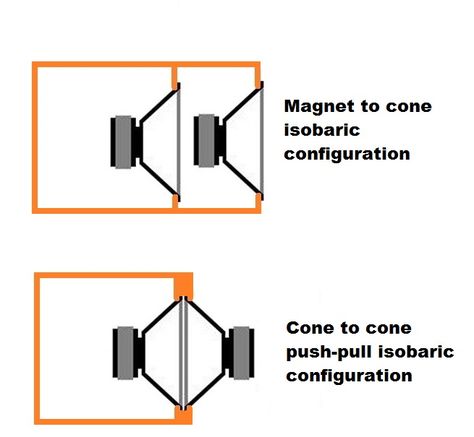
These two set ups would best suite our needs I think
I will get some of those speakers in and have a play.
Try the push-pull facing each other version first. I remember this worked best for a small enclosure I made once upon a time. I will say definitely follow the positive and negative indicators on the board with this one. Yeah people tend to ignore it but with the inner speaker you want that wired properly with the exterior one running reversed. Also give them at least 1-2mm space in between to avoid face/cone contact. I’ve seen our little 24 and 28mm speakers jump a distance you’d not expect.
i will mock something up and give it a go.
i’m thinking that it might not work as well as we hope as running 2 speakers reduces the output from the amplifier and so the speakers are not as loud.
i have tested a similar set up but had the speaker magnet to magnet in a push pull configuration and that was rather disappointing with its results.
@profezzorn i think i remember reading in the manual somewhere that you can dedicate an output for audio to run a separate amp? is this correct?
if so it would mean that we could use one that has a bit more power and get better results.
found it… Data 4 – neopixel Data 4 output, free, or audio DAC output.
@profezzorn how easy is this to implement?

